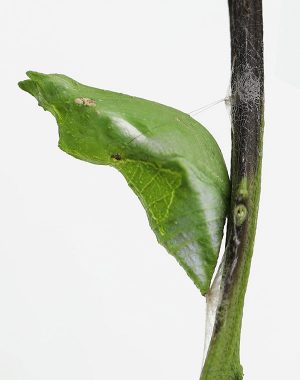FOR IMMEDIATE RELEASE
“How Do Butterflies Use Silk to Attach their Pupae to Trees?”
ACS Biomaterials Science & Engineering
Most of us learned about butterfly metamorphosis as a kid — a wriggly caterpillar molts its skin to form a tough chrysalis and emerges as a beautiful butterfly. But how exactly do chrysalises stay anchored as the butterfly brews within? Research published in ACS Biomaterials Science & Engineering shows that, despite their silks being weak and thin on their own, caterpillars can expertly spin them into chrysalis support structures resembling hook-and-loop fasteners and multi-strand safety tethers.

Silk is a natural protein-based fiber that’s commonly associated with silkworms, but it’s also produced by other insects, including butterflies. In their caterpillar stage, butterflies use silk for spinning tethers to protect themselves from falls, tying up leaf bundles to hide in and weaving little silk carpets to latch onto while undergoing metamorphosis. When forming a chrysalis, caterpillars use a special arm-like structure called a cremaster that can grab this silk carpet and secure its chrysalis to a branch. Some species of butterflies go a step further and spin a special seatbelt around their thorax for extra security. But how strong is that silk, and what kind of structures make up these seatbelts and silk carpets? Qingyou Xia, Zhaoming Dong and colleagues raised some caterpillars and found out.
The researchers raised two species of butterflies — Danaus chrysippus (plain tiger) and Papilio polytes (Common mormon) — and two species of silkworms, which they allowed to form chrysalises or cocoons, respectively. The team collected the silk threads that attached the chrysalises to branches or formed the cocoons and measured the diameters and tensile strengths. They found that butterfly silk was thinner and weaker than silkworm silk. When the primary structural proteins in the silks were analyzed, the researchers saw that butterfly silk has fewer beta sheet structures compared to silkworm, and that likely contributes to its relative weakness.
Despite this, the team found that both species of butterflies adopt unique strategies to make the most of their silk. The cremaster appendage affixes itself to the silk carpet just like a hook-and-loop fastener and the anchor shape of the cremaster’s hooks makes for a secure bond. When forming their silk seatbelts, caterpillars spin together approximately 20 different strands into a rope-like form, which increases its strength eight-fold. The researchers say their results help explain the unique strategies that caterpillars use to stay safe and secure until they emerge in their final butterfly forms.
The authors acknowledge funding from the National Natural Science Foundation of China, the National Key Research and Development Program of China, the Natural Science Foundation of Chongqing and the Fundamental Research Funds for the Central Universities.
###
The American Chemical Society (ACS) is a nonprofit organization chartered by the U.S. Congress. ACS’ mission is to advance the broader chemistry enterprise and its practitioners for the benefit of Earth and all its people. The Society is a global leader in promoting excellence in science education and providing access to chemistry-related information and research through its multiple research solutions, peer-reviewed journals, scientific conferences, eBooks and weekly news periodical Chemical & Engineering News. ACS journals are among the most cited, most trusted and most read within the scientific literature; however, ACS itself does not conduct chemical research. As a leader in scientific information solutions, its CAS division partners with global innovators to accelerate breakthroughs by curating, connecting and analyzing the world’s scientific knowledge. ACS’ main offices are in Washington, D.C., and Columbus, Ohio.
To automatically receive press releases from the American Chemical Society, contact newsroom@acs.org.
Note: ACS does not conduct research, but publishes and publicizes peer-reviewed scientific studies.



